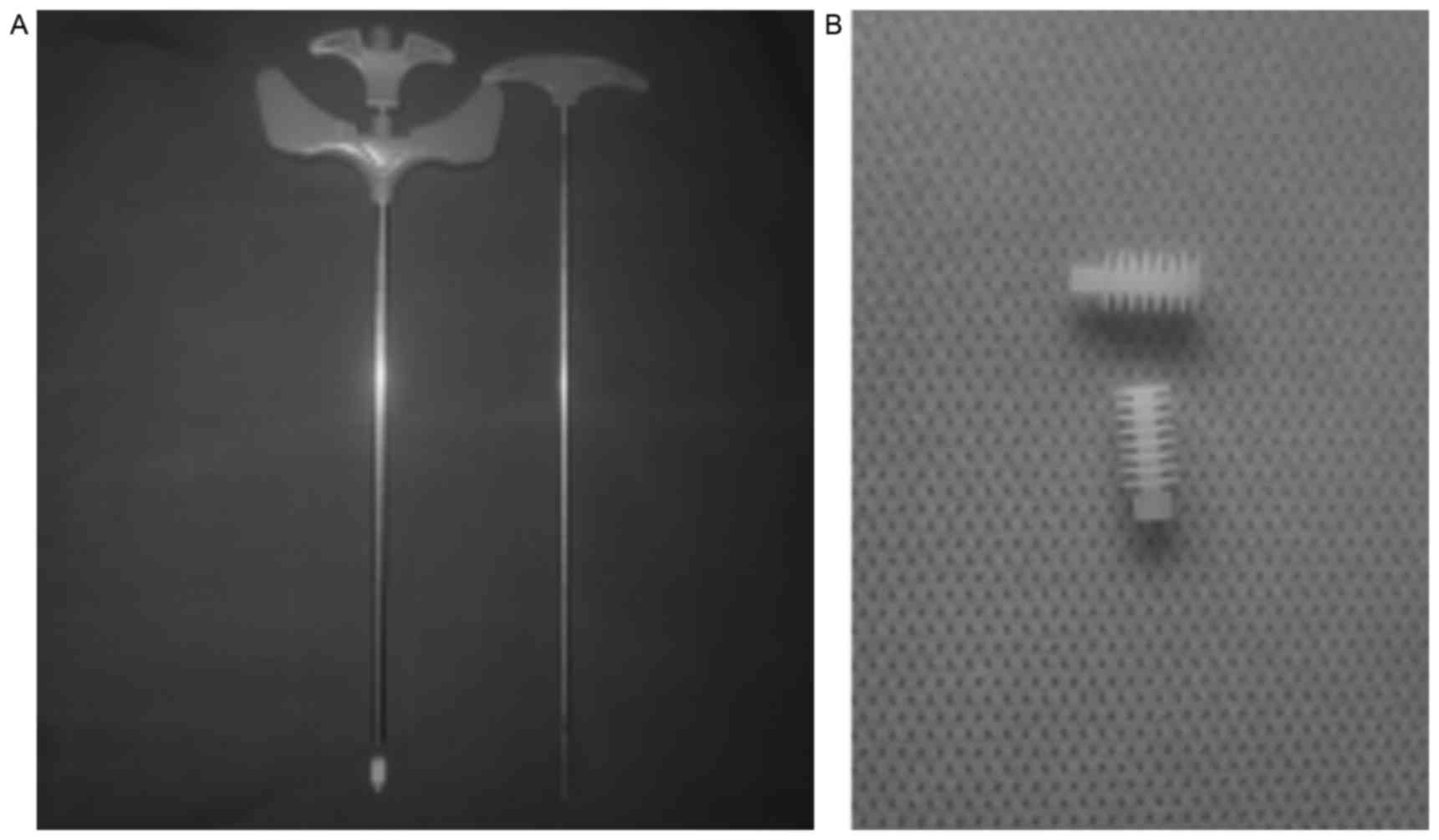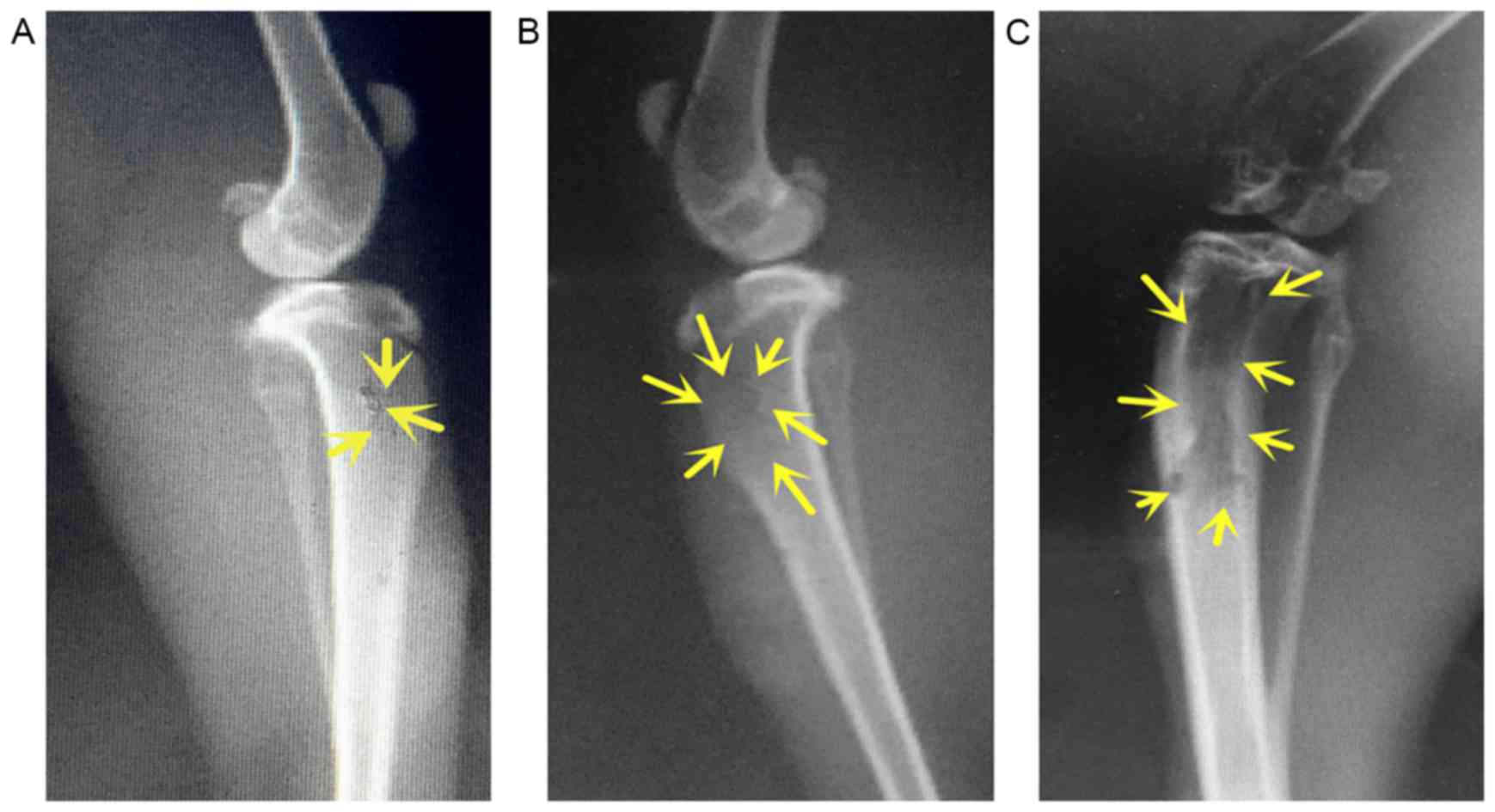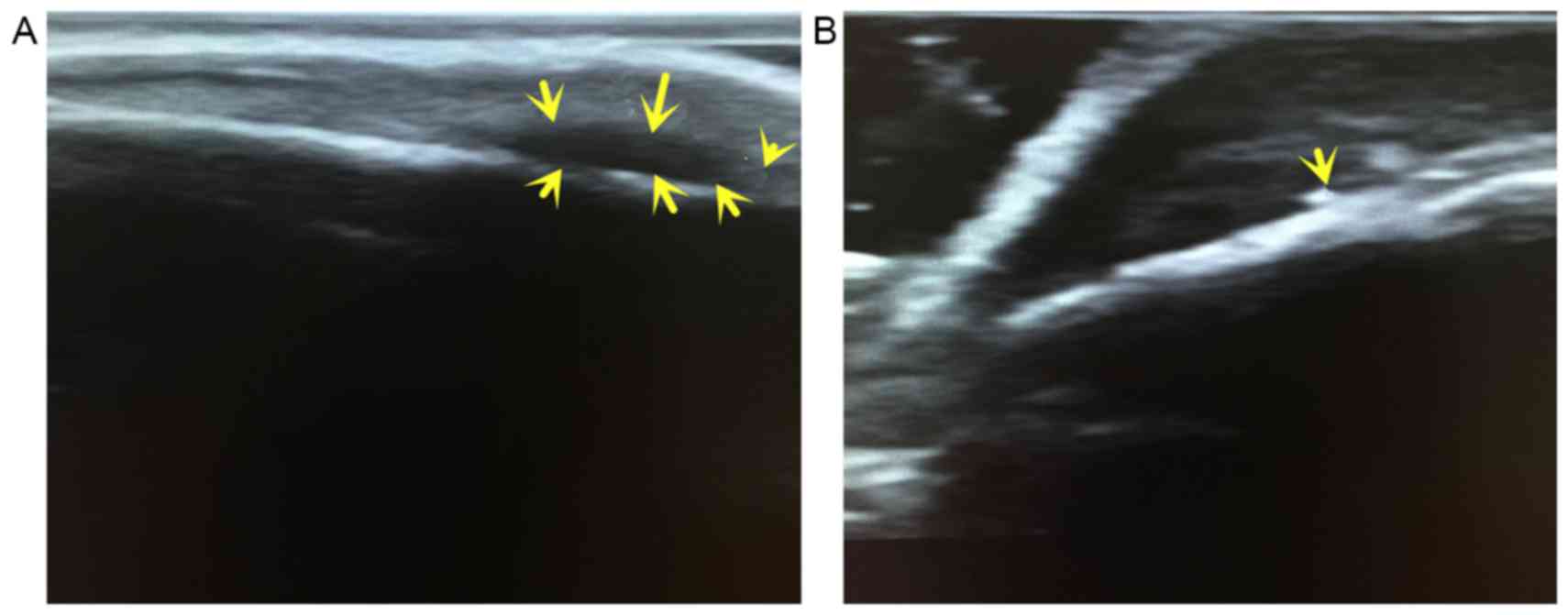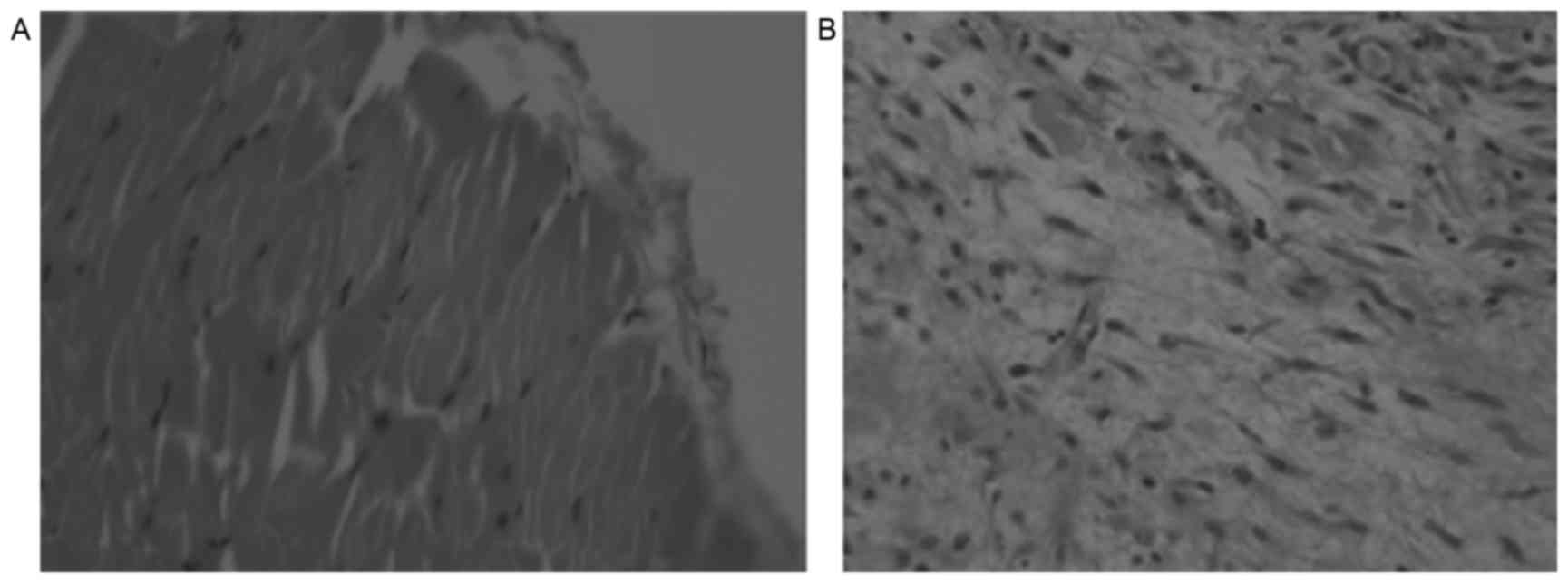An improved biopsy technique for rabbits with VX2 bone tumors
- Authors:
- Published online on: June 4, 2018 https://doi.org/10.3892/ol.2018.8881
- Pages: 2299-2304
-
Copyright: © Cao et al. This is an open access article distributed under the terms of Creative Commons Attribution License.
Abstract
Introduction
With the development of the Chinese economy and an improvement in living standards, lifestyles have recently changed and the incidence of tumors (particularly bone tumors) is higher than that previously reported (1,2). Although sophisticated imaging techniques provide significant information for the diagnosis of bone tumors, tumor biopsies are essential for making the final diagnosis (3–6). Numerous biopsy methods can be used, such as a closed biopsy or an incision biopsy, which can increase the accuracy of a tumor diagnosis; however, these methods can result in complications such as bleeding and tumor spreading (7). With the development of biopsy techniques, the needle biopsy has become a popular method; it is currently used in clinical practice, as it can be performed easily and reduces trauma (8). However, it may result in local exudation due to puncture holes, tumor cell spreading or other complications. In order to reduce needle biopsy complications, we improved the method and designed blot closures to block the puncture holes in order to reduce local exudation. We have obtained a patent for this improved biopsy technique in China. In the current study, rabbits with VX2 bone tumors were used, as the VX2 tumor is an implantable malignant papilloma that can be inoculated into the lungs, liver, muscle or bone (9,10). The VX2 rabbit bone tumor model has relevant biological characteristics that can be used to imitate human metastatic bone tumors (11). In the present study, the efficacy of a traditional biopsy technique and the improved biopsy method was compared in 20 rabbits with VX2 bone tumors by ultrasonography and pathological examination. The data showed that the improved biopsy method could reduce the rates of local exudation through puncture holes and tumor spreading.
Materials and methods
Animals
A total of 20 New Zealand rabbits (female; 4–5 months; weighing 2–3 kg; the Laboratory Animal Farm of Chunle, Tianjin, China) were used for this study. The environment was kept at 25°C and humidity 50%. A 12/12 h light/dark cycle was maintained. Access to food and water was restricted (twice per day). The new biopsy and bolt closure instruments and metallic casing are our patented products, which are available for purchase from the Affiliated Hospital of Chengde Medical College (Chengde, China) (Fig. 1). This study was performed in accordance with the regulations for the protection of animal and medical rights. The study was performed in strict accordance with the recommendations in the Guide for the Care and Use of Laboratory Animals of the National Institutes of Health. The animal use protocol has been reviewed and approved by the Institutional Animal Care and Use Committee of the Affiliated Hospital of Chengde Medical College (Chengde, Hebei, China).
Production of VX2 tumor cell suspensions
The VX2 tumor cells (Jennio biotech company, Guangzhou, China) were injected into the left vastus lateralis of the rabbit for serial subcultivation, and Color Doppler ultrasonography (Medical Systems-LOGIQ9, GE Healthcare, Chicago, IL, USA) was used to assess the tumor. After 3 weeks, once the tumor size had reached a maximum of 2×2×2 cm, rabbits with VX2 muscle tumors were secured to the animal dissecting table subsequent to administration of anesthesia (sodium pentobarbital, 35 mg/kg) via the ear vein. An incision was made in the overlying skin and tissue, and then the VX2 tumor was resected. The tumor was resected carefully following elimination of necrotic and surrounding fibrous tissues, and then placed in phosphate-buffered saline (PBS) at 37°C. Next, the tumor was cut into 1×1×1-mm sections. Subsequent to the sections being centrifuged for 5 min at 3,960 × g at 20°C (centrifugal radius, 13.5 cm), the supernatant was removed. The pieces were again placed in PBS and centrifugation was repeated under the same conditions. A tumor cell suspension of 106 cells/ml was ultimately prepared. All procedures were performed on a sterile bench. The tumor cells or tissue were stored in cryogenic refrigerator at −80°C until subsequent use. The size of any regrowth or metastasis was small, measuring ~0.5×0.5×0.5 cm.
Preparation of the rabbit VX2 bone tumor model
A total of 20 rabbits were secured to the animal dissecting table after administering anesthesia (sodium pentobarbital, 35 mg/kg) via the ear vein. The hair on each lower extremity was removed, and then the surgical field was disinfected and outlined using sterile towels. An ~1-cm skin incision was made along the medial tibia stem epiphysis, and the muscle was separated to expose the tibial metaphyseal bone. A Kirschner wire (1.6 mm) was applied to puncture the tibial metaphyseal bone and then placed parallel to the long axis of the tibia. When the wire was passed through the marrow cavity at a distance of ~2 cm, the tumor cell suspension (0.3 ml) was transplanted into the tibia and the puncture hole was closed using bone wax, thus establishing the bone tumor model. This procedure was performed for each lower limb. Radiography (X-ray apparatus; model no. OEC9800; GE Healthcare) was performed on the tibias of each of the 20 rabbits every 7 days to assess tumor growth. Radiography performed 1 or 2 weeks after VX2 tumor cell transplantation showed that the tumors were growing slowly in the medullary space and that the cortices of the bones were not broken. Radiography performed in a preliminary experiment on additional rabbits revealed that in the third week the tumors grew rapidly and that the cortices of the bones were partially destroyed (Fig. 2). The rabbit model of bone tumors at the second week was therefore used for further study.
Improved biopsy technique to puncture VX2 bone tumors
A total of 20 rabbits with bone tumors were secured to the animal dissecting table after administering anesthesia (sodium pentobarbital, 35 mg/kg) via the ear vein. The hair on the lower extremities was removed, and the surgical field was disinfected and outlined by sterile towels. All the left tibial tumors were punctured with the improved biopsy method (the experimental group). When the puncture needle reached the tumor, the stylet was pulled out and the casing was maintained in a stable position; the needle was then inserted across the casing, and several pathological samples of the tumor were obtained. Bolt closures were implanted into the puncture holes through the casing after biopsy. All the right tibias were punctured using the traditional biopsy technique (control group), and the puncture holes were not blocked (Fig. 3).
Postoperative evaluation
Color Doppler ultrasonography was performed to assess the exudation of the puncture holes in the 20 rabbits after 1 h. After 7 days, the 20 rabbits were sacrificed via air embolism, after administering anesthesia (sodium pentobarbital, 40 mg/kg) via intraperitoneal injection, and soft tissues, which were 0.5 cm away from the puncture holes, were obtained. The tissues were cut into 2×2×2 mm sections, incubated in 10% formalin (25°C) for 12 h, then the tissue sections were placed into increasing alcohol gradient (75, 80, 90%) for dehydration. After 5 h, the transparent sections were put into molten wax and embedded. When embedded successfully, the wax block was cut into 5 µm-thick slices and fixed on the glass slide. When the section was de-waxed, the section was heated for 20 min at 60°C prior to being de-waxed. Then sections were placed in the xylol (100%) for 20 min, the section was then placed into the xylol (50%) for 5 min (25°C). The sections were the rehydrated in a descending alcohol series (100, 95, 90, 80 and 70%) for 5 min at room temperature. Hematoxylin-eosin staining of the soft tissue was performed (eosin, 0.5% for 3 min; hematoxylin, 1% for 5 min) at room temperature, and the samples were examined using light microscopy (magnification, ×20; Olympus-BX53, Olympus Corporation, Tokyo, Japan). The microscopic results were investigated by a pathologist in a blinded manner to determine tumor cell spreading.
Statistical analysis
SPSS17.0 (SPSS, Inc., Chicago, IL, USA) was used for the statistical analysis. The exudation rate through the puncture hole in VX2 bone tumors and the tumor spread rate in the soft tissue near the puncture hole of the experimental and control groups were analyzed using χ2 tests. Theoretical frequency (12) (TRC=nR × nC/n, where TRC represents the theoretical frequency from the R row and the C column, nR and nC represent the total number of the R row and the total number of the C column, n=40) was calculated as T>5, n=40, χ2=(ad-bc)2n/(a+b)(c+d)(a+c)(b+d); where a, b, c and d represent actual frequency with P<0.05 considered to indicate a statistically significant difference.
Results
Imaging results
The success rate of the model was 100% for the 20 rabbits. After 1 h, color Doppler ultrasonography showed that all the closures covered the puncture holes; 5 cases in the experimental group showed a certain degree of exudation around the puncture holes, while 16 cases in the control group showed the same (Fig. 4).
Pathological results
After 2 weeks, pathological examinations showed that tumor cells were found in the soft tissue near the puncture holes in 7 cases in the experimental group and in 17 cases in the control group (Fig. 5).
Statistical results
The exudation rate through the puncture holes in the experimental group was significantly lower than that in the control group (25 vs. 80%; χ2=12.13; P<0.05; Table I). The rate of tumor spread in the experimental group was significantly lower than that in the control group (35 vs. 85%; χ2=10.41; P<0.05; Table II).
Table I.Comparison of the exudation rate of the puncture holes in the VX2 bone tumors between the experimental and control groups. |
Table II.Comparison of tumor the spreading rate in the soft tissue near the puncture holes in the VX2 bone tumors between the experimental and control groups. |
Discussion
In recent years, cancer has become the leading cause of mortality among Chinese residents, and the incidence of bone tumors is higher than ever previously recorded (2). Tumor diagnosis depends on the clinical features of a tumor, including those observed on sophisticated imaging techniques and pathological analyses. However, a tumor biopsy is critical to make a final diagnosis. An accurate pathological diagnosis is important not only for choosing the appropriate treatment plan, but also for determining the disease prognosis (13–15).
The methods used to perform biopsies to remove bone tumor tissue include closed biopsies, incision biopsies and excision biopsies. The advantages of incision biopsies include obtaining a sufficient tumor sample and a high diagnostic accuracy (16). The disadvantages are bleeding and local tumor cell spread. Additionally, the incision may affect the subsequent surgical treatment. Closed biopsies include aspiration and needle biopsies (17,18). A needle biopsy results in less trauma and bleeding, and it can be performed easily; hence, it is the most common method used by orthopedic physicians. The disadvantages of a needle biopsy are that a smaller tumor sample is obtained and that it has a lower diagnostic accuracy compared with incision biopsy. When the biopsy is completed, the physician must compress the puncture hole to arrest bleeding. As the aperture of the puncture hole is small, the tissue will heal naturally. Owing to the pressure difference between the tumor and the environment, tissue fluids will diffuse outside the tumor and may form hematomas, leading to tumor cell spread. Any biopsy technique destroys the tissue around the tumor, resulting in exudation or tumor cell spread (6–8). In the current study, the new biopsy instruments and bolt closures that aided in reducing biopsy complications are our patented products (Chinese patent no. 201310050606.1). The metallic casing serves a major role in physical isolation when it is inserted into a puncture hole. Bolt closures were implanted into the puncture holes through the casing after obtaining adequate tissue, thereby preventing tissue fluids from permeating through the holes, and thus, resulting in less local exudation and tumor spreading.
The rabbit VX2 bone tumor model was chosen in the current study due to its stable biological characteristics (19–21). A preliminary study in the rabbits using radiography showed that the tibial bone tumors were growing slowly in the medullary space 1 and 2 weeks after VX2 tumor cell transplantation, and that the cortices of the bones were unbroken (data not yet published). Radiography at the third week showed that the tumors were growing quickly and that the cortices of the bones were partially destroyed; however, there were no evident masses in the surrounding soft tissues (22). These results were verified in the current study. The 2-week model was used in this study to eliminate the effect of the tumor on the surrounding soft tissue and to ensure the reliability of the results. Experimental results were compared using the χ2 test; all tested differences were statistically significant, indicating that the improved biopsy method can prevent local exudation and tumor spreading.
In conclusion, the improved biopsy technique not only results in physical isolation of the puncture hole, but also blocks the holes. The bolt closure is made of a polymer that can be implanted into the human body and is steadily fixed into the holes to prevent local bleeding and tumor spread. The preliminary experiment of the present study demonstrated that this improved biopsy technique could lessen the exudation of puncture holes in the ilium. In future, the improved biopsy technique should be continuously improved and verified. Furthermore, it provides a solid foundation for future clinical applications.
Acknowledgements
The authors would like to thank the staff at the Affiliated Hospital of Chengde Medical College, including Professor Chunhui Li (Department of Pathology) and Professor Peiming Feng (Department of Imaging) for their assistance.
Funding
This study was part of the program of the key project funded by the Science and Technology Department of Hebei Province, China (grant no. 14277790D).
Availability of data and materials
The datasets used and/or analyzed during the current study available from the corresponding author on reasonable request.
Authors' contributions
HC, YJ, JZ, ZF, JW, YW and JL contributed to the conception and design of the study, interpretation of data, revision of the manuscript and approval of the final draft for publication. HC and YJ were the major contributors in manuscript writing. JZ constructed the bone tumor model; ZF and JW interpreted all color doppler ultrasonography, pathological examinations and Radiography scans. YW performed the statistical analysis. All authors read and approved the final manuscript.
Ethics approval and consent to participate
The Regional Committees for the Affiliated Hospital of Chengde Medical College approved the study. All participants gave written informed consent.
Consent for publication
All participants gave written informed consent.
Competing interests
The authors declare that they have no competing interests.
References
|
Ramdass MJ, Mooteeram J, Beharry A, Mencia M and Barrow S: An 8-year analysis of bone tumors in a Caribbean island. Ann Med Surg (Lond). 4:414–416. 2015. View Article : Google Scholar : PubMed/NCBI | |
|
Barnes M, Tiwana MS, Kiraly A, Hutchison M and Olson RA: Incidence of distal bone metastases in patients treated for palliative radiotherapy and associations with primary tumor types. J Bone Oncol. 4:107–109. 2015. View Article : Google Scholar : PubMed/NCBI | |
|
Munk PL: Bone Biopsy-Safe, successful and satisfying for all. J Vasc Interv Radiol. 14:323–327. 2003. View Article : Google Scholar : PubMed/NCBI | |
|
Chew C, Reid R and O'Dwyer PJ: Value of biopsy in the assessment of a retroperitoneal mass. Surgeon. 4:79–81. 2006. View Article : Google Scholar : PubMed/NCBI | |
|
Cotter JA, Yu A, Kreitenberg A, Haddad FH, Baker MJ, Fox JC and Adams GR: Suction-modified needle biopsy technique for the human soleus. Aviat Space Environ Med. 84:1066–1073. 2013. View Article : Google Scholar : PubMed/NCBI | |
|
Virayavanich W, Ringler MD, Chin CT, Baum T, Giaconi JC, O'Donnell RJ, Horvai AE, Jones KD and Link TM: CT-guided biopsy of bone and soft-tissue lesions: Role of on-site immediate cytologic evaluation. J Vasc Interv Radiol. 22:1024–1030. 2011. View Article : Google Scholar : PubMed/NCBI | |
|
Oliveira MP, Lima PM and de Mello RJ: Tumor contamination in the biopsy path of primary malignant bone tumors. Rev Bras Ortop. 47:631–637. 2015. View Article : Google Scholar : PubMed/NCBI | |
|
Welker JA, Henshaw RM, Jelinek J, Shmookler BM and Malawer MM: The percutaneous needle biopsy is safe and recommended in the diagnosis of musculoskeletal masses. Cancer. 89:2677–2686. 2000. View Article : Google Scholar : PubMed/NCBI | |
|
Qian T, Chen M, Gao F, Meng F, Gao X and Yin H: Diffusion-weighted magnetic resonance imaging to evaluate microvascular density after transarterial embolization ablation in a rabbit VX2 liver tumor model. Magn Reson Imaging. 32:1052–1057. 2014. View Article : Google Scholar : PubMed/NCBI | |
|
Kim KW, Lee JY, Lee JM, Jeon YS, Choi YS, Park J, Kim H, Han JK and Choi BL: High-intensity focused ultrasound ablation of Soft-tissue tumors and assessment of treatment response with multiparametric magnetic resonance imaging: Preliminary study using rabbit VX2 tumor model. J Med Ultrasound. 22:99–105. 2014. View Article : Google Scholar | |
|
Fujimiya K, Sugihara K and Nishikawa T: Experimental study on the role of osteoclasts and free radicals in the mandibular invasion of VX2 carcinoma in Japanese white rabbits. Bone. 20:245–250. 1997. View Article : Google Scholar : PubMed/NCBI | |
|
Sun ZQ and Xu YY: The medical Statistics (the third editon)(M). Beijing, People's Medical Publishing House; pp. 112–113. 2010 | |
|
Mankin HJ, Mankin CJ and Simon MA: The hazards of the biopsy, revisited. Members of the Musculoskeletal Tumor Society. J Bone Joint Surg Am. 78:656–663. 1996. View Article : Google Scholar | |
|
Talac R and McLain RF: Biopsy principles and techniques for spinal tumors. Semin Spine Surg. 21:70–75. 2009. View Article : Google Scholar | |
|
Gikas PD, Keller S, Boyle R and Stalley PD: Principles of the surgical management of bone tumours. Orthopaedics Trauma. 29:160–162. 2015. View Article : Google Scholar | |
|
Skrzynski MC, Biermann JS, Montag A and Simon MA: Diagnostic accuracy and charge-savings of outpatient core needle biopsy compared with open biopsy of musculoskeletal tumors. J Bone Joint Surg Am. 78:644–649. 1996. View Article : Google Scholar : PubMed/NCBI | |
|
Carrino JA, Khurana B, Ready JE, Silverman SG and Winalski CS: Magnetic resonance imaging-guided percutaneous biopsy of musculoskeletal lesions. J Bone Joint Surg Am. 89:2179–2187. 2007. View Article : Google Scholar : PubMed/NCBI | |
|
Singh HK, Kilpatrick SE and Silverman JF: Fine needle aspiration biopsy of soft tissue sarcomas: Utility and diagnostic challenges. Adv Anat Pathol. 11:24–37. 2004. View Article : Google Scholar : PubMed/NCBI | |
|
Munver R, Threatt CB, Delvecchio FC, Preminger GM and Polascik TJ: Hypertonic saline-augmented radiofrequency ablation of the VX-2 tumor implanted in the rabbit kidney: A short-term survival pilot study. Urology. 60:170–175. 2002. View Article : Google Scholar : PubMed/NCBI | |
|
Amundson E, Pradilla G, Brastianos P, Bagley C, Riley LH III, Garonzik IM, McCarthy E, Wolinsky JP and Gokaslan ZL: A novel intravertebral tumor model in rabbits. Neurosurgery. 57:341–346. 2005. View Article : Google Scholar : PubMed/NCBI | |
|
Chen H, Jia M and Xu W: Malignant bone tumor intramedullary invasion: Evaluation with dual-energy computed tomography in a rabbit model. J Comput Assist Tomogr. 39:70–74. 2015. View Article : Google Scholar : PubMed/NCBI | |
|
Errani C, Kreshak J, Ruggieri P, Alberghini M, Picci P and Vanel D: Imaging of bone tumors for the musculoskeletal oncologic surgeon. Eur J Radiol. 82:2083–2091. 2013. View Article : Google Scholar : PubMed/NCBI |














